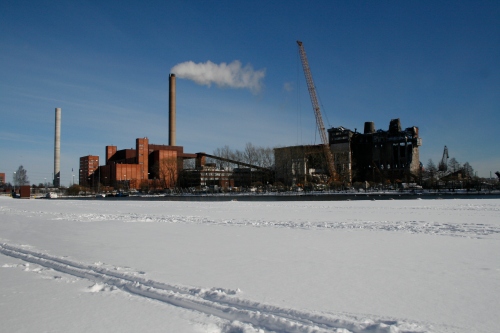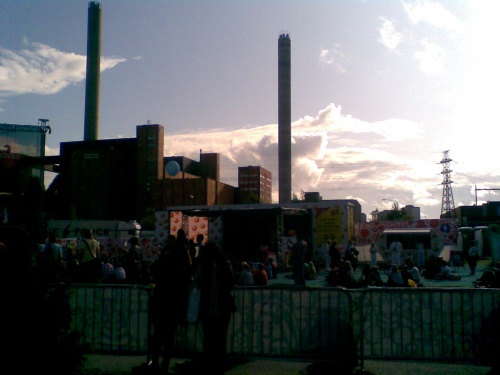Spotting the signs of ancient human settlement or, to be precice, human handiwork, in a landscape, is the work of archaeologists. They can “read” a bump in a field which looks utterly natural to most of us as the product of a particular time and culture, say early neolithic as distinct from middle neolithic. Southern England, for instance, is full of burial mounds and other archaeological sites that you could easily overlook – unless you happen to be able to tell your bell barrow from your disc barrow.
The other day I was just a little surprised to hear a rumbling and then see the bright headlights, as a lorry drove up from underneath this mound. OK, it’s got that typical  Finnish/Helsinki bare rock, which tells you that as a bump in the landscape its not a burial barrow but the trace of warming climates and something called the Palaeoproterozoic age. No matter, it’s integral to modern life in Helsinki today. Integral, that is, to the city’s ongoing fascination with the underground.
Finnish/Helsinki bare rock, which tells you that as a bump in the landscape its not a burial barrow but the trace of warming climates and something called the Palaeoproterozoic age. No matter, it’s integral to modern life in Helsinki today. Integral, that is, to the city’s ongoing fascination with the underground.
It is, of course, the entrance to one of the many, many underground constructions in this holey city. Since no car park or transport connection is marked for this site on any of the maps in the Underground Development Plan, it seems likely that it’s the entrance to an underground shelter or bunker, Punanotkon puiston kalliosuoja. (Bunkers for civil defence deserve their own post, here I’ll just note how odd it was that until the rumbling lorry drew my attention to it, I’d never even noticed the tunnel.)
And of course, it did make one wonder about this mania for building underground. Though there’s all kinds of stuff underground, there are also thousands of spaces for private cars. There are 16 underground car parks in the central area alone. And a lot of the recent blasting underground has been about bringing in even more cars. Which is also odd, since central Helsinki is a small, compact peninsula with excellent public transport connections and a haf-decent cycle network. Driving in a private car and contributing to existing congestion is definitely not the smartest way to get here.
On which note, it’s also odd that the development plan writes of a Central Tunnel in the present tense. It’s been the dream of car-dependents in the Helsinki region for decades, the idea being to improve east-west traffic flow by building a tunnel from the end of the western motorway (from Espoo) or Länsiväylä all the way to Sörnäisten Rantatie in the east. With cost estimates from 340 million Euros to 750 million Euros (a couple of years ago) no wonder the scheme was put to rest by the councillors. For now.
Meanwhile, that Planning Department publication (my translation) notes that:
Keskustatunneli is a street of 4km located in a tunnel … The tunnel has several junctions linking it to the surface street grid, the city centre’s parking facilities and the central service tunnel. The tunnel is a double tunnel with a dedicated tunnel for traffic in both directions. The tunnel is not for the use of light transport, lorries or dangerous transports. An environmental impact assessment has been made.
If you only read that part of its underground plan, you’d be forgiven for believing that said tunnel is already there.
You have to finish the paragraph to find out that writing in the present indicative tense amounts to wishful thinking on the part of some incorrigible auto-fanatic transport planner with the world-view of a 1950s North American road-engineer. Before moving on, it finally hints that the tunnel is but a plan. It has aims and objectives.
The aim of the tunnel is to improve the vitality and accessibility of the centre and facilitate east-west links, transport safety, amenity values and to enhance opportunities for pedestrianising the city centre. The objective is also to lessen noise and pollution.
Exactly how hiding cars underground out of sight, that routinely drive in from the surrounding, growing sprawl of Finland’s increasing love-affair with detached houses, furthers any other objective than traffic growth and unhealthy lifestyles (and bigger backsides) is uncle ar.
ar.
Well, not unclear to everyone. Besides various political parties and councillors who have resisted the tunnel idea over the years, there are a good number of active citizens around who are opposed and keeping an eye on the situation, for example, loosely translated, “let’s kick the central tunnel up its posterior”.
Then again, there are lots of things other than cars that you can put into an underground tunnel. Municipal infrastructure for example. Pipes, to you and me. This cool image is from the famed Development Plan pdf available here.
P.S. the snow has finally arrived. We will endeavour to capture its effects on camera before it melts again. Thinking of Copenhagen…





 Photographed here 2 years ago before it got covered in scaffolding but several years after it was resized by its new neighbours, Kiasma and Sanomatalo.
Photographed here 2 years ago before it got covered in scaffolding but several years after it was resized by its new neighbours, Kiasma and Sanomatalo. The government gave
The government gave  Not only are cars and delivery vehicles to be hidden away from view in tomorrow’s Helsinki, today we learn that waste, solid waste as well as sewage, is to be whisked out of sight and out of mind on the city’s new waterfront developments (at least Jätkäsaari and Kalasatama). It will be sucked into giant vacuum tubes underground where not rats and above all no local seagulls will get at it.
Not only are cars and delivery vehicles to be hidden away from view in tomorrow’s Helsinki, today we learn that waste, solid waste as well as sewage, is to be whisked out of sight and out of mind on the city’s new waterfront developments (at least Jätkäsaari and Kalasatama). It will be sucked into giant vacuum tubes underground where not rats and above all no local seagulls will get at it.